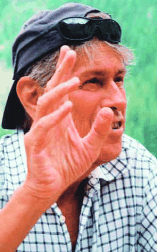Pierre-Gilles de Gennes (1932–2007)
Pierre Gilles de Gennes passed away on May 18, 2007. It was a surprise to some, but his close collaborators had known for a long time of his illness. He remained scientifically active in the Institut Curie, where he worked primarily on biology after retiring as head of Ecole de Physique et Chimie de Paris and as a chair at the Collège de France in the year 2000.
De Gennes received the Nobel Prize in Physics in 1991 “for discovering that methods developed for studying order phenomena in simple systems can be generalized to more complex forms of matter, in particular to liquid crystals and polymers”. This was a very unusual declaration for a Nobel committee, as it did not point out any particular discovery but rather a general coverage of a large scientific domain often called “soft condensed matter”. De Gennes could have just as easily received the Nobel Prize in Chemistry, as did Paul Flory in 1974, his predecessor in applying statistical physics concepts to polymers.

Pierre-Gilles entered Ecole Normale Supérieure in natural science in 1951. He later described this period, which involved a lot of descriptive science, observation, and analysis, as an essential element of his training. He passed the French Agrégation examination in physics and chemistry, which implies an advanced education in both disciplines. He compensated the disadvantage of this overly classical training by attending the Les Houches theoretical physics school and by studying under the supervision of Charles Kittel in Berkeley.
He started his research in 1955 by working in Saclay on spin fluctuations in a magnetic systems next to a Curie point. In 1961, he was invited by Jacques Friedel to become a professor in the solid-state physics laboratory in Orsay, where he was very successful in founding an experimental and theoretical group on superconductivity: his book Superconductivity of Metals and Alloys1 remains a classical reference work.
He then moved to the physics of liquid crystals.2 The field had been somewhat obscured by false analysis in terms of “swarms” of particles, and he correctly described the physics in terms of continuous models by using analogies with other fields of condensed matter. The continuous transition between nematic and smectic phases as well as that due to the tilt of the director field between smectic A and C phases were understood as analogues of the superfluid λ transition. Again, he was particularly concerned with experiments: Instabilities in the presence of external fields were studied by a team headed by Georges Durand, I worked with Pavel Piéranski on hydrodynamics, and Maurice Kléman worked on defects, as well as boundary conditions and surface anchoring effects. To achieve this project he insisted that there should be a chemistry lab in the group, and he always considered chemists (Lionel Liébert and Lechek Strelecki) as equal partners. He liked to quote a conversation with Robert Meyer (Harvard University): In 1974, Bob was spending a year in Orsay, and he suggested, while the two were queuing at the cafeteria, that the symmetry breaking needed for ferroelectricity in liquid crystals could be achieved by using a chiral smectic C phase. The phase was synthesized and its ferroeletric properties were identified within a couple of weeks!
De Gennes moved in 1971 to Collège de France, where he focused on polymers.3 Among his numerous discoveries on polymers, two contributions, quite opposite in style, stand out: the renormalization group solution (the so-called n=0 limit) and the reptation model dealing with disentanglement of chains, for which he interacted strongly with Sam Edwards.
De Gennes was always interested in what happened at interfaces: proximity effects in superconductors, boundary conditions in liquid crystals, grafting of polymers, and the effect of surfaces on polymer configurations or the so-called Navier slip length for shearing of a liquid along a solid surface. He also worked a lot on problems on the statics and dynamics of wetting, whereby, depending on the scale, van der Waals interactions, viscosity, or inertia control the flow.
De Gennes was concerned with industrial applications, as he felt he could contribute as well as get inspiration. He was curious of everything in science and life, but he did not like to be considered a “touche à tout” as he always went deeply in each of the problems he worked on, even if he liked to present them in the most simple and pedagogical way whatever the audience.
He was very generous in sharing his curiosity and findings with his group (and was always mindful that males and females were equally represented). He was also very open to younger students when he visited schools, where he had an unmistakable style in which all pretension was excluded. His closest collaborator and partner, Professor Françoise Brochard-Wyart was asked recently how she felt to have lived in the shadow of a great man. She answered, “not in the shadow; in the light”. Most of his collaborators feel the same today.




